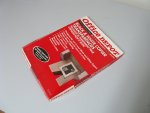Accordion Reed Valves.
Coming from a post war era of make-do and mend I easily empathise with having a go and making my own. However it’s important to understand that this philosophy has its limits and when it comes to some matters ‘accordion’ I believe it has.
Plastic, like steel, is produced to have specific qualities depending on its intended purpose. Its springy-ness and ability to recover from being blown open, for instance, would be a desirable quality for an accordion valve but not necessarily be a quality required for a floppy disc maker or ordinary sheet of plastic for ordinary stationery purposes. I personally doubt if the ‘elastic limits’ of many ordinary everyday plastics would stand up to the task of opening and closing reliably over many years as purpose made valves do.
The task of valve renewal is time consuming and to replace a lot of valves, particularly the inside valves, with home made ones is not a risk I would take.
Leather valves are different being a natural material though, like plastic, I would expect that its qualities are an experts field.
Felts and leathers vary greatly in quality and those available in ordinary d-i-y stores can easily fall short of what is required for an accordion. Years ago I used chamois leather from such a source to line a complete set of palettes. The accordion was playable but not really air-tight. After a long process of elimination I discovered that the fault was the palettes and when I relined them proper selected chamois material the problem disappeared.
So many of the accordion repair tasks are labour intensive that, for me, the risk of using non-standard material is just too great.


